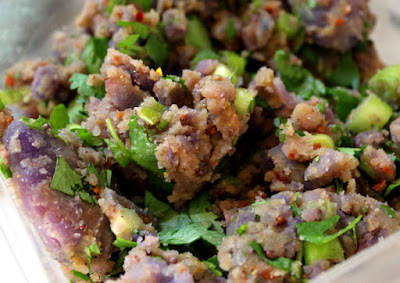If you're anything like me, there's nothing less motivating than the prospect of cooking lunch for one.
Here's what happens. Somewhere around midday, if I'm working from home, I think of something I'd like to eat. And then I think about the number of pots involved, and the fact that I will be the only one eating...and perhaps most significantly, the only one cleaning up afterward...and that dinner comes after lunch, which will mean even more cleaning. Then, in response to this disheartening realization, one part of my mind earnestly tries to convince the other part that a spoonful of peanut butter is really a very well-balanced meal, if you think about it, because it contains protein and um and uh protein and well anyway there would only be a single utensil to wash afterward. (Inevitably, five minutes after I implement this idea, I'm both hungry and glaring at the stupid spoon sitting expectantly in the sink.)
So the other day, I am in exactly this situation—post-peanut butter, pre-spoon-cleaning—and thinking guiltily of the rampant African blue basil on the balcony that has grown to the size of a small elephant in the moist summer heat. A gangly, adolescent elephant. It was gazing reprovingly at me through the balcony door window.
I thought about how I should prune it, and how I was hungry, and how I needed to stop anthropomorphizing plants. (This last part I may have said aloud to our houseplants, Ellie and Beatrix, who nodded knowingly in the circulating air from the ceiling fan.)
And then, less than twenty minutes later, I was sitting down to this. The ingredients can be prepared while the pasta water is coming to a boil. The water boils quickly, because you can use a small pot. And most magically of all,
everything happens in that one small pot—leaving you just one thing to clean up afterward.*
Plus it's like mac and cheese comfort meets homemade pesto gourmet deliciousness.
Ingredients (per person):
1 small to medium clove garlic, unpeeled
A bit more than 1 cup whole wheat fusilli pasta**
A big bunch of fresh basil (say, 2 generous handfuls...you'll want about 1/2 cup chopped)
1-2 oz grated extra sharp cheddar (or sub Parmesan, Asiago, or any full-flavored cheese)
Any other pasta-y ingredients that happen to be languishing in your fridge (optional)***
A scattering of pine nuts (optional)
Salt & freshly ground black pepper
Bring a pot of water to a boil for the pasta (a 2 quart pot is fine for a single serving). Toss in a 1/2 tsp salt.
While you're waiting for it to boil, wash, dry, and chop up the basil (you want enough for about 1/2 cup chopped), grate the cheese, and assemble any other ingredients.
When the water boils, add the garlic clove and the pasta. Boil for 7 1/2 minutes or follow package directions, until al dente. 1 minute before the pasta is done, fish out the garlic clove, rinse briefly under cold water, peel, and smash or chop.
Drain the pasta (directly from the pot if you can, using the lid, to save yourself the bother of cleaning something else), and replace the pot full of pasta back on the stove. Drizzle with olive oil, stir in the garlic and basil and any other pasta-y ingredients you've decided to add, and let sit one minute to warm through. Add the cheese and pine nuts and stir gently until the cheese melts. Sprinkle with black pepper, and serve.

*And the fork, technically. And a plate, if you're being all formal.
**If you're looking for the best store-bought whole wheat pasta by far, ever, look no further than
Eden Organic Kamut spirals.
***e.g., a spoonful or two of
roasted red pepper tapenade, a chopped artichoke heart, a little diced tomato, and/or a scattering of chopped parsley.

















































